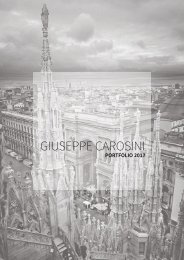You also want an ePaper? Increase the reach of your titles
YUMPU automatically turns print PDFs into web optimized ePapers that Google loves.
THEORETICAL<br />
UNDERPINNINGS<br />
Radical Architecture<br />
The architectural theory of our project has been loosely based on<br />
many principles derived from some of the honorary and often controversial<br />
minds within our field. The work done by Rem Koolhaas, the<br />
proverbial father of our current epoch of architecture, in his project<br />
Exodus provides a strong understanding in what it means to challenge<br />
current norms of society, and the concept of inversion and in his case<br />
perversion of social constructs, re-interpreting these as architectonic<br />
manifestations. Where his project in its execution is highly dystopic,<br />
we look to utilize his approach to challenging the norm and creating<br />
a paradigm shift which ultimately is defined through the physical outcome<br />
of the project itself. His work, radical by nature is put together<br />
closely with the work by Superstudio’s - Continous Monument, which<br />
again shows how a singular concept aimed to challenge a widely<br />
accepted norm is used as the driver of the architectonic project.<br />
Situationist International<br />
116 REFUGIUM<br />
“They rejected the idea that advanced capitalism’s apparent successes—such<br />
as technological advancement, increased income, and<br />
increased leisure—could ever outweigh the social dysfunction<br />
and degradation of everyday life”<br />
Despite of the mentioned progress and advancement nothing has<br />
been undertaken to ease and make the refugee Journey less dangerous<br />
and more humane. Situationist theory, intertwined with concepts<br />
like unitary urbanism and psycho-geography, while strongly challenging<br />
political norm through its avant-garde approach is what we see as<br />
an indispensable precedent to learn from. Without a level of change<br />
outside of architecture itself, there is no possibility to address a global<br />
problem such as the refugee crisis.<br />
The Society of the Spectacle<br />
“The spectacle is not a collection of images,” Debord writes, “rather, it<br />
is a social relationship between people that is mediated by images.”<br />
The spectacle obfuscates the past, imploding it with the future into an<br />
undifferentiated mass, a type of never-ending present; in this way the<br />
spectacle prevents individuals from realizing that the society<br />
of spectacle is only a moment in history. Aligned with this is the crisis<br />
of refugees. Ever changing and fluctuating with intensity throughout<br />
history.<br />
The concept brought forward by the Society of Spectacle is found both<br />
in the problem we face, and manifests itself simultaneously as the<br />
solution, where the dichotomous relationship between refugees and<br />
architecture needs to ebb and flow, integrating a multitude of aspects<br />
and requiring an entirely new archetype in order to function.




